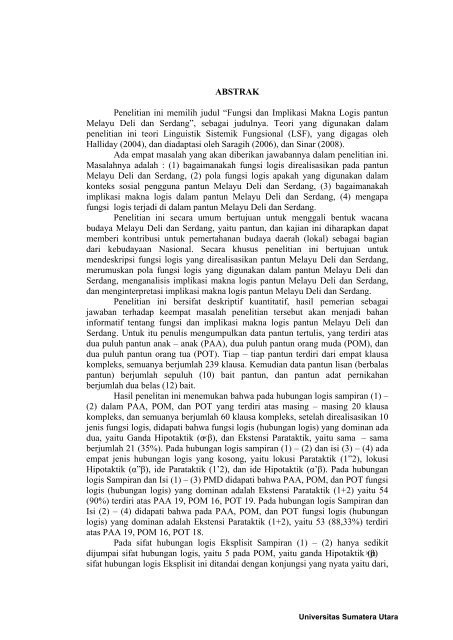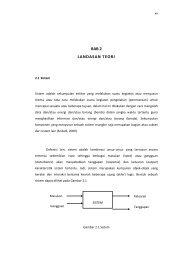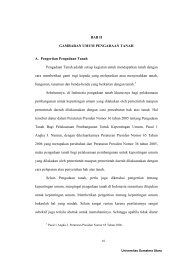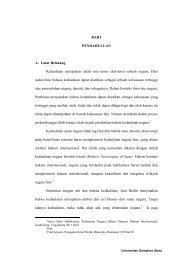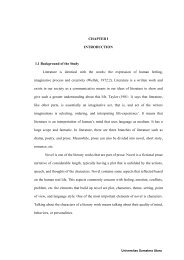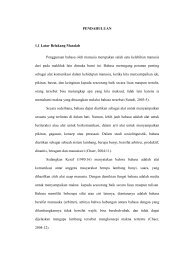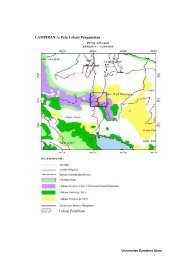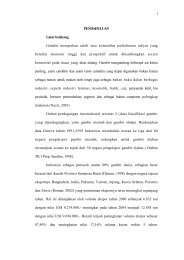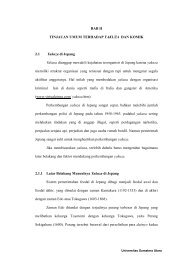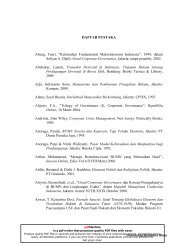Fungsi Dan Implikasi Makna Logis - USU Institutional Repository
Fungsi Dan Implikasi Makna Logis - USU Institutional Repository
Fungsi Dan Implikasi Makna Logis - USU Institutional Repository
You also want an ePaper? Increase the reach of your titles
YUMPU automatically turns print PDFs into web optimized ePapers that Google loves.
ABSTRAK<br />
Penelitian ini memilih judul “<strong>Fungsi</strong> dan <strong>Implikasi</strong> <strong>Makna</strong> <strong>Logis</strong> pantun<br />
Melayu Deli dan Serdang”, sebagai judulnya. Teori yang digunakan dalam<br />
penelitian ini teori Linguistik Sistemik <strong>Fungsi</strong>onal (LSF), yang digagas oleh<br />
Halliday (2004), dan diadaptasi oleh Saragih (2006), dan Sinar (2008).<br />
Ada empat masalah yang akan diberikan jawabannya dalam penelitian ini.<br />
Masalahnya adalah : (1) bagaimanakah fungsi logis direalisasikan pada pantun<br />
Melayu Deli dan Serdang, (2) pola fungsi logis apakah yang digunakan dalam<br />
konteks sosial pengguna pantun Melayu Deli dan Serdang, (3) bagaimanakah<br />
implikasi makna logis dalam pantun Melayu Deli dan Serdang, (4) mengapa<br />
fungsi logis terjadi di dalam pantun Melayu Deli dan Serdang.<br />
Penelitian ini secara umum bertujuan untuk menggali bentuk wacana<br />
budaya Melayu Deli dan Serdang, yaitu pantun, dan kajian ini diharapkan dapat<br />
memberi kontribusi untuk pemertahanan budaya daerah (lokal) sebagai bagian<br />
dari kebudayaan Nasional. Secara khusus penelitian ini bertujuan untuk<br />
mendeskripsi fungsi logis yang direalisasikan pantun Melayu Deli dan Serdang,<br />
merumuskan pola fungsi logis yang digunakan dalam pantun Melayu Deli dan<br />
Serdang, menganalisis implikasi makna logis pantun Melayu Deli dan Serdang,<br />
dan menginterpretasi implikasi makna logis pantun Melayu Deli dan Serdang.<br />
Penelitian ini bersifat deskriptif kuantitatif, hasil pemerian sebagai<br />
jawaban terhadap keempat masalah penelitian tersebut akan menjadi bahan<br />
informatif tentang fungsi dan implikasi makna logis pantun Melayu Deli dan<br />
Serdang. Untuk itu penulis mengumpulkan data pantun tertulis, yang terdiri atas<br />
dua puluh pantun anak – anak (PAA), dua puluh pantun orang muda (POM), dan<br />
dua puluh pantun orang tua (POT). Tiap – tiap pantun terdiri dari empat klausa<br />
kompleks, semuanya berjumlah 239 klausa. Kemudian data pantun lisan (berbalas<br />
pantun) berjumlah sepuluh (10) bait pantun, dan pantun adat pernikahan<br />
berjumlah dua belas (12) bait.<br />
Hasil penelitan ini menemukan bahwa pada hubungan logis sampiran (1) –<br />
(2) dalam PAA, POM, dan POT yang terdiri atas masing – masing 20 klausa<br />
kompleks, dan semuanya berjumlah 60 klausa kompleks, setelah direalisasikan 10<br />
jenis fungsi logis, didapati bahwa fungsi logis (hubungan logis) yang dominan ada<br />
dua, yaitu Ganda Hipotaktik (α×β), dan Ekstensi Parataktik, yaitu sama – sama<br />
berjumlah 21 (35%). Pada hubungan logis sampiran (1) – (2) dan isi (3) – (4) ada<br />
empat jenis hubungan logis yang kosong, yaitu lokusi Parataktik (1”2), lokusi<br />
Hipotaktik (α”β), ide Parataktik (1’2), dan ide Hipotaktik (α’β). Pada hubungan<br />
logis Sampiran dan Isi (1) – (3) PMD didapati bahwa PAA, POM, dan POT fungsi<br />
logis (hubungan logis) yang dominan adalah Ekstensi Parataktik (1+2) yaitu 54<br />
(90%) terdiri atas PAA 19, POM 16, POT 19. Pada hubungan logis Sampiran dan<br />
Isi (2) – (4) didapati bahwa pada PAA, POM, dan POT fungsi logis (hubungan<br />
logis) yang dominan adalah Ekstensi Parataktik (1+2), yaitu 53 (88,33%) terdiri<br />
atas PAA 19, POM 16, POT 18.<br />
Pada sifat hubungan logis Eksplisit Sampiran (1) – (2) hanya sedikit<br />
dijumpai sifat hubungan logis, yaitu 5 pada POM, yaitu ganda Hipotaktik ×β) (α<br />
sifat hubungan logis Eksplisit ini ditandai dengan konjungsi yang nyata yaitu dari,<br />
Universitas Sumatera Utara
kalau, kalaupun,. Pada POT sifat hubungan logis Eksplisit sampiran hanya 1,<br />
yaitu ganda Hipotaktik ×β). (α Sedangkan pada PAA tidak dijumpai sifat<br />
hubungan logis Eksplisit Sampiran (1) – (2). Pada Sifat hubungan logis Implisit<br />
Isi (3) – (4) ini, konjungsi sebagai fungsi logis tidak nyata, akan tetapi<br />
keberadaannya dapat dipahami. Pada PAA dijumpai sifat hubungan logis Eksplisit<br />
Sampiran, seperti Elaborasi Parataktik (1×2), Ekstensi Parataktik, Ganda<br />
Parataktik (1×2), Ganda Hipotaktik α×β). ( Pada POM dijum pai Ekstensi<br />
Parataktik (1+2), Ganda Parataktik (1×2), Ganda Hipotaktik (α× β). Pada sifat<br />
hubungan logis Implisit semua klausa menggunakan konjungsi, terutama<br />
konjungsi dan.<br />
Pada sifat hubungan logis Eksternal Sampiran dan Isi (1) – (3) Sifat<br />
hubungan logis Eksternal pada PAA didapati pada Ekstensi Parataktik (1+2) pada<br />
PAA (3, 7,11, 15, 19, 23, 27, 31, 35, 39, 43, 47, 51, 59, 63, 67, 71, 75, 79)<br />
semuanya menggunakan konjungsi dan. Pada POM juga dijumpai Ekstesi<br />
Parataktik (1+2), yaitu 167, 175, 179, 183, 187, 191, 195, 199, 203, 207, 211, 215,<br />
219, 223, 227, 231, 235, 239, seluruhnya menggunakan konjungsi dan. Ganda<br />
Hipotaktik (α×β) 163 dengan konjungsi α×β.<br />
Pada sifat hubungan logis internal Sampiran dan Isi (2) – (4) pada PAA<br />
dijumpai Ekstensi Parataktik (1+2) yaitu (4, 8, 12, 16, 20, 24, 28, 32, 40, 44, 48,<br />
52, 56, 60, 64, 68, 72, 76, 80) seluruhnya menggunakan konjungsi dan, ganda<br />
Hipotaktik (α×β) yaitu (36) menggunakan konjungsi untuk. Pada POM dijumpai<br />
Ekstensi Parataktik (1+2) yaitu : 84, 88, 92, 96, 100, 104, 108, 112, 116, 120, 124,<br />
128, 132, 148, 152, 160, seluruhnya menggunakan konjungsi dan, ganda<br />
Hipotaktik (α×β), yaitu (140, 144, 156). Pada POT dijumpai Ekstensi Parataktik<br />
(1+2) yaitu : 168, 172, 176, 180, 188, 196, 200, 204, 208, 212, 216, 220, 224, 228,<br />
236, 280, seluruhnya menggunakan konjungsi dan, ganda Hipotaktik (1×2), yaitu<br />
192, 164.<br />
Pada analisis Proses dan Sirkumstan PAA, POM, dan POT baris (1) – (2),<br />
dijumpai PAA proses yang dominan adalah Proses Material, Sirkumstan yang<br />
dominan Sirkumstan Lokasi : Tempat Proses dan Sirkumstan pada baris (3) dan<br />
(4) yang dominan adalah Proses Mental, Sirkumstan yang dominan adalah<br />
Sirkumstan Sebab. Pada POM Proses dan Sirkumstan baris (1) – (2) didapati<br />
proses yang dominanpaling tinggi adalah Proses Material, Sirkumstan yang<br />
tertinggi, Sirkumstan Lokasi : Tempat . Pada Proses dan Sirkumstan pada baris (3)<br />
– (4), Proses yang dominan adalah Proses Material, Sirkumstan yang tertinggi,<br />
Sirkumstan Lokasi : Waktu, tempat, Sirkumstan Cara, dan Sirkumstan Hal. Pada<br />
POT Proses dan Sirkumstan Baris (1) – (2), Proses yang dominan adalah Proses<br />
Material, Sirkumstan tang tertinggi Sirkumstan lokasi : Tempat. Proses dan<br />
Sirkumstan Baris (3) – (4), Proses yang dominan Proses Mental, Sirkumstan yang<br />
dominan adalah Sirkumstan Hal.<br />
Pada konteks situasi Pantun Lisan (berbalas pantun) didapati bahwa<br />
pemantun tidak siap dengan pantun – pantunnya, pemantun banyak gugup dan<br />
lupa akan pantun yang dijualnya. Sedangkan pada pantun perkawinan, walau<br />
pemantun dihadapkan dengan lawan pantunnya, aturan pantun tetap terjaga.<br />
Rumus ab-ab nya terjaga baik. Pada pantun perkawinan didapati bahwa di<br />
samping bersifat logogenetik fonologis juga bersifat filogenetik etnografis.<br />
Universitas Sumatera Utara
Pantun yang merupakan kearifan lokal secara konseptual merupakan<br />
kebijaksanaan masyarakat Melayu Deli dan Serdang.<br />
Universitas Sumatera Utara
ABSTRACT<br />
The title of this study is “Function and Implication of Logical Meaning of<br />
pantun Melayu Deli and Serdang”. This study employed Functional Systemic<br />
Linguistics (FSL) theory developed by Halliday (2004) and adapted by Saragih<br />
(2006) and Sinar (2008).<br />
There were four research questions to be answered in this study such as (1)<br />
how the logical function is materialized in pantun Melayu Deli and Serdang, (2)<br />
which pattern of logical function is used in the social context of the users of<br />
pantun Melayu Deli and Serdang, (3) what implication of logical meaning is<br />
found in pantun Melayu Deli and Serdang, and (4) why the logical function<br />
occurred in pantun Melayu Deli?<br />
The purpose of this study, in general, was to explore the form of cultural<br />
discourse of Melayu Deli such as pantun, and the result of this study is expected<br />
to be a contribution to maintain local culture as part of national culture. In<br />
particular, the purpose of this study was to describe the logical function<br />
materialized in pantun Melayu Deli and Serdang, to formulate the pattern of<br />
logical function used in pantun Melayu Deli and Serdang, and to interprete the<br />
implication of logical meaning of pantun Melayu Deli and Serdang.<br />
This is a qualitative descriptive study, the answers to the four research<br />
questions will be an informative materials about the function and implication of<br />
logical meaning of pantun Melayu Deli and Serdang. For that purpose, the writer<br />
collected the data of written pantun consisting of 20 (twenty) pantun for children<br />
(PAA), 20 (twenty) pantun for young people (POM), and 20 (twenty) pantun for<br />
old people (POT). Each pantun consists of 4 (four) complex clauses and all of<br />
them are 239 clauses. Then the data of oral pantun (exchanging pantun) consisted<br />
of 10 (ten) stanzas, and pantun for traditional marriage ceremony comprised 12<br />
(twelve) stanzas.<br />
The result of this study showed that in the logical relationship of sampiran<br />
(1) – (2) in PAA, POM, and POT which consisted of 20 (twenty) complex clauses<br />
respectively, and all together there were 60 complex clauses, after being<br />
materialized there were 10 kinds of logical functions, and it was found out that<br />
there were two dominant logical functions (logical relationships), namely,<br />
multiple Hypotactic (α x β), and Extension Paratactic, both of them were 21 (35%).<br />
In the logical relationship of sampiran (1) – (2) and content (3) – (4), there were 4<br />
(four) kinds of “empty” logical relationships, namely, Paratactic Locution (1”2),<br />
Hypotactic Locution (α”β), Paratactic Idea (1’2), Hypotactic Idea (α’β). In the<br />
logical relationship of sampiran and content (1) –(3) of pantun Melayu Deli and<br />
Serdang, it was found out that the dominant logical function (logical relationship)<br />
of PAA, POM and POT was Extension Paratactic (1 + 2) (54 = 90%) consisting of<br />
19 PAA, 16 POM, and 19 POT. In the logical relationship of sampiran and<br />
content (2) – (4) of pantun Melayu Deli and Serdang, it was found out that the<br />
dominant logical function (logical relationship) of PAA, POM and POT was<br />
Extension Paratactic (1 + 2) (53 = 88.33%) consisting of 19 PAA, 16 POM, and<br />
18 POT.<br />
In the traits of logical relationship of Explicit Sampiran (1) – (2), only 5<br />
(five) logical relationship traits were found in POM, such as, multiple Hypotactic<br />
Universitas Sumatera Utara
(α x β) marked with real conjunction such as dari, kalau, kalaupun. In POT, only 1<br />
(one) logical relationship trait was found, namely multiple Hypotactic (α x β).<br />
While in PAA, no trait of logical relationship of Explicit Sampiran (1) – (2) was<br />
found. In the traits of logical relationship of Implicit Isi (Content) (3) – (4),<br />
conjunction as logical function was unreal, but its existence was understandable.<br />
The traits of logical relationship of Explicit Sampiran were found in PAA such as<br />
Paratactic Elaboration (1x2), Paratactic Extension, Multiple Paratictic (1x2), and<br />
Multiple Hypotactic (α x β). In POM, Paratactic Extension (1+2), Multiple<br />
Paratactic (1x2), and multiple Hypotactic (α x β) were found. In the traits of<br />
implicit logical relationship, all of the clauses used conjunction, especially<br />
conjunction “dan”.<br />
In the traits of logical relationship of Explicit Sampiran and Isi (Content)<br />
(1) – (3), the traits of external logical relationship were found in Paratactic<br />
Extension (1+2) in PAA (3, 7, 11, 15, 19, 23, 27, 31, 35, 39, 43, 47, 51, 59, 63,<br />
67, 71, 75, 79) which all of them used conjunction “dan”. Paratactic Extension<br />
(1+2) was also found in POM (167, 175, 179, 183, 187, 191, 195, 199, 203, 207,<br />
211, 215, 219, 223, 227, 231, 235, 239) which all of them also used conjunction<br />
“dan”. Multiple Hypotactic (α<br />
x β) (163) was with conjunction α x β.<br />
In the traits of internal logical relationship of Sampiran and Content (2) –<br />
(4), a Paratactic Extension (1+2) was found in PAA (4, 8, 12, 16, 20, 24, 28, 32,<br />
40, 44, 48, 52, 56, 60, 64, 68, 72, 76, 80) which all of them used conjunction<br />
“dan”, Multiple Hypotactic (α<br />
x β) (36) was with conjunction “untuk”. Paratactic<br />
Extension (1+2) was also found in POM (84, 88, 92, 96, 100, 104, 108, 112, 116,<br />
120, 124, 128, 132, 148, 152, 160) which all of them used conjunction “dan”, and<br />
Multiple Hypotactic (α x β) (140, 144, 156). Paratactic Extension (1+2) was also<br />
found in POT (168, 172, 176, 180, 188, 196, 200, 204, 208, 212, 216, 220, 224,<br />
228, 236, 280) which all of them used conjunction “dan”, and Multiple Hypotactic<br />
(1x2) (192, 164).<br />
In the analysis of Process and Circumstance of PAA, POM, and POT line<br />
(1) – (2), the dominant process found in PAA was Material Process, and the<br />
dominant circumstance was Location of Circumstance: The dominant location of<br />
Process and Circumstance in lines (3) – (4) was Mental Process and the dominant<br />
Circumstance was Circumstance of Cause. In the Process and Circumstance lines<br />
(1) – (2) in POM, it was found out that the highest dominant process wa Material<br />
Process , and the highest Circumstance was the Circumstance of Location: Place.<br />
In the Process and Circumstance in lines (3) – (4), the dominant Process was<br />
Material Process, and the highest Circumstance was Circumstance of Location:<br />
Time, Place, Circumstance of Way, and Circumstance of Thing. In the Process<br />
and Circumstance in lines (1) – (2) of POT, the dominant Process was Material<br />
Process, and the highest Circumstance was Circumstance of Location: Place. In<br />
the Process and Circumstance in lines (3) – (4), the dominant Process was Mental<br />
Process, and the dominant Circumstance was Circumstance of Thing.<br />
In the context of Oral Pantun (Exchanging Pantun), it was found out that<br />
the pantun readers were not ready with their pantuns; they felt very nervous that<br />
they forgot the pantuns they would deliver to the other contestants. While in the<br />
pantun for marriage ceremony, even though the pantun readers were faced to their<br />
Universitas Sumatera Utara
opponents, the rule of the pantun was well maintained. Its ab-ab rhyme was well<br />
maintained. It was also found out that the pantuns for marriage ceremony were<br />
either phonological logogenetic or ethnographical phylogenetic in nature.<br />
Pantun is conceptually a local wisdom of Melayu Deli and Serdang<br />
community.<br />
Universitas Sumatera Utara


